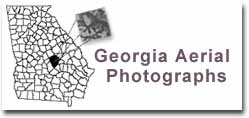
| Digital Library of Georgia |
 |
|
||
| About the Project | |||
|
Getting Started In 2002, The Digital Library of Georgia began digitizing aerial photographs
from the State of Georgia to be made available for use on GALILEO. Held
by the University Libraries’ Map Collection, 50,000 of nearly 220,000
photographs were selected to comprise this online database. Photographs
of counties with major cities were initially selected to be digitized
with additional photos being selected alphabetically. The counties currently
included in this database may be viewed on the Current
Online Holdings list. Digitization Process and Standards The digitization of this project was split into two parts. Digital Library of Georgia staff was responsible for scanning 20,000 individual photos only. For the remaining 28,000 photos and 5,500 index photos, the Digital Library of Georgia contracted with East View Cartographic, Inc. The majority of the original collection consists of 9" x 9" black and white photographs on paper and film. The photographs required cleaning prior to scanning to remove photogrammetric markings. To clean the photographs, we used electric erasers fitted with blue vinyl eraser strips specifically made for use on photos and film. Afterwards, the photos were scanned on a flatbed scanner at 600 dpi, 8-bit grayscale. Minor adjustments, such as contrast and brightness, were made to the photos, as necessary, to improve image quality. The original or master images are LZW compressed TIFF (Tagged Image File Format) format files averaging 16 to 25 megabytes in size. From the master TIFF images, MrSid images were created for use on this database. MrSid is developed and maintained by Lizardtech. This file format allows the viewer to zoom in or out on each image to see finer detail. Also, this format allows the user to print a zoomed and/or cropped portion of the image to any available paper size. Brief History of Aerial Photographs
After World War I, U.S. aerial photography was slow to develop but there were several private firms and individuals producing a limited number of photos. The development of major federal projects began during the Depression and led to major sections of the U.S. being photographed during the 1930s. The Tennessee Valley Authority used aerial photography and newly developed photogrammetric equipment to map areas of the Tennessee River Valley. Farmers participating in farm programs needed accurate measurements of their farms. Precise measurements at that time, however, could only be made by surveyor's chains being carried around the fields and the maps being drawn by hand. A quicker, cheaper way had to be created since there were millions of acres to measure and map across the country. In 1935 USDA began to use rectified-to-scale aerial photography to efficiently measure acreage. Today, the Aerial
Photography Field Office (APFO) has aerial photomaps that cover all
of the nation's major cropland. Aerial photography dating from 1955 to
present is currently available through the APFO and consists primarily
of 9" x 9" film negatives. Digital imagery is currently being
archived and developed at the APFO to meet USDA Service Center requirements. |
|||

in association with the Map Collection, UGA Science Library
